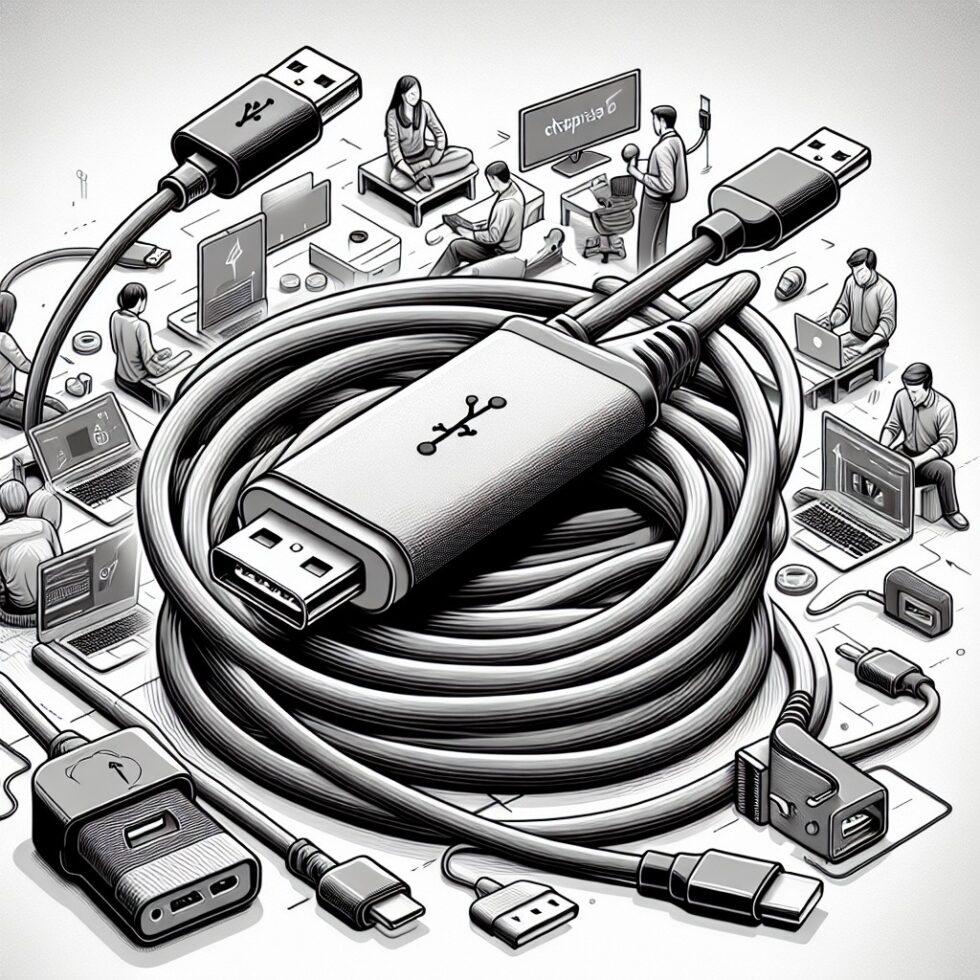
USB‑C is supposed to make life easier. One plug, any direction, fewer adapters. In practice, it can feel like a puzzle. Some cables carry only a trickle of data but lots of power. Some chargers fast‑charge your phone but trickle your laptop. Some hubs light up one display, not two. And a surprising number of problems come down to the wrong cable for the job.
This guide is your practical map through the mess. We’ll keep the jargon low, the checklists short, and the explanations concrete. By the end, you’ll know how to build a reliable everyday kit, pick parts that match your devices, and avoid the most common pitfalls—without buying a drawer full of duplicates.
The USB‑C basics you actually need
USB‑C is just the shape of the connector. What flows through that connector can be very different. Think of four layers that stack together:
- Connector: USB‑C (the oval port and cable plug)
- Power: USB Power Delivery (PD) versions and wattage, including PPS and EPR
- Data speed: USB 2.0 (480 Mbps), USB 3.x (5–20 Gbps), USB4 (up to 40 Gbps), or Thunderbolt
- Video: DisplayPort Alt Mode, or video tunneled inside USB4/Thunderbolt
Every device and cable supports a specific mix of these. When something doesn’t work, it’s usually because one piece in the chain can’t do the thing you’re trying to do—fast power, fast data, or video.
Decoding a cable label
All USB‑C cables look similar, but their guts differ a lot. The key specs to check are:
- Power rating: 60 W (3 A cables), 100 W (5 A), or 240 W (EPR‑capable). For 100 W+ you need an e‑marked cable with a smart chip.
- Data speed: 480 Mbps (USB 2.0), 5/10/20 Gbps (USB 3.x), 40 Gbps (USB4/Thunderbolt). Many “charging” cables only do 480 Mbps.
- Video support: Either via DisplayPort Alt Mode (common on phones and many PCs) or via USB4/Thunderbolt tunneling (common on newer laptops and docks).
- Length and type: Passive cables are fine up to 1 m for high speeds. Longer high‑speed cables may be active and directional.
If a cable listing doesn’t clearly state both power and data specs, assume the worst. For laptops and 4K displays, look for certified logos and explicit wording like “USB4 40 Gbps, 240 W EPR, e‑marked.”
Charger ratings that matter
USB Power Delivery (PD) is how chargers and devices decide on voltage and current. Three terms you’ll encounter:
- PD 3.0: Fixed steps like 5 V, 9 V, 15 V, 20 V up to 100 W.
- PD 3.1 EPR: Adds 28 V, 36 V, and 48 V up to 240 W for larger laptops and some docks.
- PPS: Programmable Power Supply, where the charger can adjust voltage in small steps for cooler, efficient fast charging on many phones.
Multi‑port GaN chargers split their max wattage across ports. Labels like “100 W total, 65 W + 30 W + 5 W” tell you what each port can deliver alone or together. Always check the fine print on the back or spec sheet.
Power: safe fast charging across phones, laptops, and accessories
Charging is where USB‑C shines, but it works best when you match a few numbers and understand the handshake.
Pick the right wattage
Here are practical targets by device type:
- Phones: 20–45 W is sufficient. PPS support helps maintain speed and reduce heat.
- Tablets and handheld consoles: 30–45 W to avoid slow charging under heavy use.
- Ultrabooks: 60–100 W depending on CPU and GPU. Many 13–14″ laptops do fine at 65 W.
- Workstations and gaming laptops: 140–240 W if they support PD charging; some still require proprietary plugs for full performance.
- Docks and hubs: Check “host power delivery” (e.g., “up to 85 W to laptop”) and add headroom for peripherals.
A simple rule: match or exceed the original charger’s wattage. Devices only draw what they need; an oversized charger is safe.
How the negotiation works
When you plug in a device, a quick negotiation happens:
- The cable tells the charger if it’s 3 A, 5 A, or EPR capable via its e‑marker chip.
- The charger offers supported voltages and currents (PD 3.0/3.1, PPS).
- The device requests the best option it supports.
If any piece in the chain can’t meet a requirement—say, no EPR cable—the device falls back to a lower power mode. That’s why a 140 W‑capable laptop might sit at 100 W and charge slowly on the wrong cable.
Keep batteries happy
Fast charging creates heat, and heat ages batteries. You can stay fast and kind by:
- Using PPS‑capable chargers for phones that support it.
- Turning on OS battery limit features (80% cap) for laptops you keep plugged in.
- Keeping chargers and cables out of blankets and tight cases to allow airflow.
Travel kit builds
Two simple kits cover most trips:
- Light kit: 65 W GaN charger with two ports, one 100 W e‑marked cable, one 60 W cable. Charges a laptop and phone overnight.
- Power kit: 140–200 W GaN charger, one 240 W EPR cable (short), one 100 W cable (long), and a compact 10 Gbps data cable for SSDs.
Label the cables with small tags: “240W/40G,” “100W/10G,” “60W/USB2.” It saves minutes every day.
Car and airplane charging
In cars, a reliable 45–65 W USB‑C PD adapter is enough for phones, tablets, and light laptops. For 12 V sockets, choose a brand that publishes real PD profiles and uses a metal heat sink. On planes, in‑seat power is often limited to 60 W or less. Expect maintenance charging, not full performance on power‑hungry laptops.
Video and data: when USB‑C carries displays and storage
USB‑C can carry video either through DisplayPort Alt Mode or by tunneling video inside USB4/Thunderbolt. Which one you get depends on your laptop, tablet, or phone. That’s why two similar‑looking docks can behave very differently.
DisplayPort Alt Mode vs USB4/Thunderbolt
DisplayPort Alt Mode (DP Alt Mode) is a direct lane mapping. Your device turns some USB‑C pins into DisplayPort lanes. It’s simple and efficient, great for single 4K displays. USB4/Thunderbolt wraps data and video together and dynamically allocates bandwidth. It’s ideal for docks with multiple 4K displays, Ethernet, and fast USB ports.
Key checkpoints:
- DP 1.4 Alt Mode: Can drive 4K60 with Display Stream Compression (DSC) or 4K30 uncompressed on many systems.
- DP 2.0/2.1 Alt Mode: Higher bandwidth for 4K120/8K on new hardware, rolling out in recent devices and docks.
- USB4 40 Gbps and Thunderbolt 4: Usually support one 8K or two 4K displays on PCs; Macs vary by model.
A laptop that supports only DP Alt Mode won’t get multi‑display magic from a Thunderbolt dock. It may still work, but with fewer displays or lower refresh rates. Check your laptop’s spec page for “USB4,” “Thunderbolt,” or “DisplayPort Alt Mode” wording.
Single‑cable docking that works
Choose the dock that matches your host:
- USB‑C DP Alt Mode hubs: Affordable; typically one 4K60 or two lower‑res displays via MST on Windows. macOS does not support MST for multiple extended displays over DP Alt Mode.
- USB4/Thunderbolt docks: More expensive; support multiple 4K displays, 2.5 GbE, fast USB, and high laptop charging. Requires a host with USB4 or Thunderbolt.
For dual 4K60 displays on Windows, a USB4/Thunderbolt dock with 85–100 W power delivery is the sweet spot. On Mac, check your model’s external display limits; some Apple Silicon laptops support only one external display without special DisplayLink adapters.
Storage and capture devices
External SSDs are fastest over 10–20 Gbps USB or 40 Gbps USB4/Thunderbolt. To avoid slowdowns:
- Use short, high‑quality 10 Gbps+ cables, not “charging only” cords.
- Look for UASP support on the drive enclosure for lower latency.
- Avoid long passive 40 Gbps cables; if you must go long, choose an active cable rated for the speed.
For capture cards and webcams, 5 Gbps links are usually fine. The bottleneck is often the software, not the port.
HDMI over USB‑C pitfalls
USB‑C to HDMI adapters convert DisplayPort Alt Mode to HDMI. To get 4K60 HDR reliably, look for an adapter with HDMI 2.0 or higher and DSC support. For gaming features like VRR and 4K120, you’ll need newer chipsets or a direct USB‑C to DisplayPort solution with a DP 1.4/2.0 monitor.
Buying and labeling: reducing everyday friction
You don’t need a box of mystery cables. You need a small set of labeled, known‑good parts.
How to choose cables
Use this short checklist:
- Power‑first cable: 240 W EPR, e‑marked, 1–2 m. Label it “240W.” This is your universal charging rope.
- Data‑first cable: 40 Gbps USB4/Thunderbolt 0.8 m. Label it “40G.” Use it for docks, fast SSDs, and high‑res displays.
- Everyday cable: 100 W, 10 Gbps 1 m. Label it “10G/100W.” It covers phones, tablets, and moderate data tasks.
Buy from brands that publish test results and certification IDs. USB‑IF certified logos and VESA/Thunderbolt labels are meaningful. If the box is vague, skip it.
Testing tools that save time
Two cheap tools turn guesswork into facts:
- USB‑C power meter: Plugs inline and shows voltage, current, and wattage. Confirms fast charge vs trickle.
- OS utilities: On Windows, USBView shows port capabilities; on Linux,
lsusb -vandboltctlreveal device and Thunderbolt info.
For deep dives, a dedicated PD analyzer or a dock with diagnostic software can read e‑marker data and PD profiles. But for everyday use, a power meter solves 80% of mysteries.
Organize a family kit
USB‑C chaos often comes from mixing unknown, old cables with new ones. Try this:
- Give each cable a clear tag with power and speed. Even a piece of tape helps.
- Keep a “fast bin” for the good stuff and a “legacy bin” for older, low‑speed cords.
- Use color coding: red for 240 W, blue for 40 Gbps, black for 10 Gbps, white for USB 2.0 charging.
Troubleshooting: fix the weird stuff
Most USB‑C problems have simple causes. Start with cables and power, then move to ports and settings.
Why a 240 W cable can be slower than a cheap one
Some high‑power cables save space by offering only USB 2.0 data. They’re perfect for charging but terrible for file transfers or docks. If your SSD crawls at 30 MB/s, swap in a “40 Gbps” or at least “10 Gbps” cable. Power capacity and data speed are independent.
Flickering monitor or no signal
- Shorten the cable. High‑bitrate video over long passive cables is fragile.
- Use a direct USB‑C to DisplayPort cable for DP monitors; avoid extra dongles.
- Check if your laptop supports DP Alt Mode multi‑display (Windows MST) or requires USB4/Thunderbolt for dual displays.
- Try an active cable or a higher‑quality adapter rated for 4K60 HDR or better.
Laptop charges slowly or discharges while in use
- On multi‑port chargers, your laptop may not be on the high‑wattage port. Move it or unplug other devices.
- Verify the cable is 5 A/e‑marked for 100–240 W charging.
- Match the charger’s wattage to the laptop’s needs; heavy GPU use might exceed what PD can provide.
Dock works, but audio crackles or USB devices disconnect
- Try a shorter, certified 40 Gbps cable for docks that push a lot of data and video.
- Move the charger to a different AC outlet if you suspect a ground loop with amplified speakers.
- Disable aggressive USB power saving in your OS for that dock’s ports.
Safety and longevity
USB‑C is robust, but physical stress and poor parts cause the rare horror stories. A few habits go a long way.
Buy trusted, inspect often
- Choose certified chargers and cables from reputable brands. Look for USB‑IF, Thunderbolt, and VESA badges.
- Inspect cable ends for wobble, bent pins, and heat discoloration. Replace frayed or deformed plugs immediately.
- Don’t use right‑angle adapters that put constant torque on a laptop port unless they have strain relief.
Keep ports clean
Laptops and phones live in pockets and backpacks. Lint in a USB‑C port can prevent a cable from seating fully, leading to arcing and heat. Power off, then use a plastic pick or a burst of air to gently clean the port. Never dig with metal tools.
Plan for battery health
- Prefer cool, steady charging over hot, rapid cycles.
- Use the OS setting that caps charge at 80% if you stay plugged in all day.
- Avoid leaving devices hot under pillows or on couches while charging.
What’s next: more bandwidth, more power, better labels
The USB‑C ecosystem continues to improve. Three trends to watch:
- USB4 Version 2: Higher data rates (up to 80 Gbps or more in asymmetric modes) for fast storage, multiple high‑resolution displays, and pro workflows.
- Thunderbolt 5: Advertised 80 Gbps bi‑directional and up to 120 Gbps for displays, along with better power and hub features on new systems.
- DisplayPort 2.1: Higher video bandwidth for 4K120/8K displays becoming mainstream in docks and monitors.
On the power side, 240 W EPR is now common in premium chargers and cables. Expect more devices—especially large laptops and creators’ docks—to use it. Finally, labeling is getting clearer: certified logos now include both speed and power. As those labels spread, the guessing game will end for good.
Mini‑playbooks you can use today
For a new laptop
- Buy a 100 W+ GaN charger with two ports, and a 240 W EPR cable.
- Pick a USB4/Thunderbolt dock if you want two external 4K displays and fast peripherals.
- Keep a short 40 Gbps cable for the dock and a longer 10 Gbps cable for general use.
For a phone‑first setup
- Get a 30–45 W PPS charger and a 100 W cable. It will also cover tablets and handheld consoles.
- Use a USB‑C to HDMI or DisplayPort adapter rated for 4K60 if your phone supports desktop mode.
For creators and remote workers
- Use a Thunderbolt/USB4 dock with 85–100 W host power. It reduces cable clutter and adds reliable Ethernet.
- Keep a labeled 40 Gbps cable with the dock. Swap it at the first sign of flicker or disconnects.
- Back up fast: pair NVMe SSD enclosures with 10–20 Gbps cables for consistent speed.
Common myths, cleared up
- “All USB‑C cables are the same.” Not even close. Power and data vary widely.
- “Higher‑wattage chargers damage small devices.” Devices negotiate what they need; higher wattage is safe.
- “If video works once, the cable is fine.” Marginal cables fail under higher resolution, refresh rate, or longer runs.
- “My laptop can run any dock.” Docks depend on your laptop’s support for DP Alt Mode vs USB4/Thunderbolt.
Build your own labeling system
Make the next two years easier by standardizing your kit:
- Pick two cable lengths: 0.8 m for high‑speed, 1–2 m for general charging.
- Use consistent tags: “40G/240W,” “10G/100W,” “USB2/60W.”
- Store cables coiled loosely and avoid sharp bends. Kinks cause intermittent failures you’ll chase for weeks.
Summary:
- USB‑C is a connector; what matters is the mix of power, data, and video a device and cable support.
- For charging: match or exceed your device’s wattage; use e‑marked cables for 100–240 W; prefer PPS for phones.
- For video: DP Alt Mode is simple for single displays; USB4/Thunderbolt is better for multi‑display docks.
- Label three cable types: 240 W charging, 40 Gbps high‑speed, and 10 Gbps everyday. Buy certified when possible.
- Fix issues by swapping cables first, then checking port capabilities and power sharing on multi‑port chargers.
- Protect gear with basic habits: inspect plugs, keep ports clean, and manage battery heat.
- New standards (USB4 v2, Thunderbolt 5, DP 2.1) bring more bandwidth and better labeling—fewer surprises ahead.





